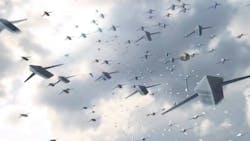Researchers approach industry for air-superiority munitions technologies like artificial intelligence (AI)
EGLIN AIR FORCE BASE, Fla. – U.S. defense contractors have just two weeks to demonstrate their interest in participating in upcoming air superiority research projects that involve enabling technologies for modeling and simulation; aircraft integration; target tracking; missile guidance and control; and artificial intelligence (AI) for swarming unmanned aircraft.
Officials of the U.S. Air Force Research Laboratory's Munitions Directorate at Eglin Air Force Base, Fla., issued a sources-sought notice (FA8651-24-S-0001) on Tuesday for the 2024 Air Dominance Broad Agency Announcement program.
This market survey is to identify potential sources with the expertise, capabilities, and experience to develop state of the art solutions in 13 air munitions-related research areas, which are:
-- modeling, simulation, and analysis;
-- aircraft integration technologies;
-- find fix target track and datalink technologies;
-- engagement management system technologies;
-- high velocity fuzing;
-- missile electronics;
-- missile guidance and control technologies;
-- advanced warhead technologies;
-- advanced missile propulsion technologies;
-- control actuation systems;
-- missile carriage and release technologies;
-- missile test and evaluation technologies; and
-- artificial intelligence and machine autonomy.
Related: The coming of age of artificial intelligence
Modeling, simulation, and analysis seeks to develop models to analyze air superiority concepts such as intercommunicative weapons, novel damage mechanisms, lethal and novel destruct mechanisms, several targeting, and time critical delivery. Detailed modeling includes sensors, aerodynamics, autopilots, navigation and guidance schemes, propulsion, warheads, fuzes, datalinks, fire control, launcher, suspension, carriage and release, error filters, environment (wind, fog, and dust), lethality, vulnerability, and threats.
Innovative aircraft integration technologies seeks to design, develop, and demonstrate physical, electrical, and logical interfaces for aircraft integration technologies.
Find-fix-target-track and datalink technologies seeks to develop technologies to detect threats to aircraft. Technologies of interest include small data link terminals for air-to-air missiles, conformal data link antennas, alternative waveforms, and applications of data links to support air-to-air missile swarming.
Engagement management system technologies seeks to make the most of aircraft survivability in increasingly contested environments while mining false positives and engagement costs. Technologies may require limited aircrew supervision or may be autonomously operated.
High-velocity fuzing involves electronic safe-and-arm technologies that can initiate a warhead safely, target detection devices and guidance integrated fuzing devices that can provide miniaturized, fast-responding, accurate range, and location information for high closure velocity intercepts for slow- and fast-moving targets.
Missile electronics seeks to investigate missile power and electronics for air-to-air missiles, involving power conversion and distribution, power generation and storage technologies, guidance electronics, and thermal management.
Missile guidance and control technologies seeks to investigate guidance algorithms against maneuvering targets, real time optimal lofting and energy management, integrated guidance and control, reduced latency between seeker measurements and final control fin commands, seeker technologies and algorithms, target state estimators, and third party queuing.
Advanced warhead technologies seeks to investigate conventional and conceptual munitions warhead technology for the destruction, damage, defeat, or denial of function of targets of interest using technologies for a robust and affordable capability of air-launched munitions.
Related: Top technology challenges this decade for the warfighter
Advanced missile propulsion technologies involves propellant formulations, grain structures, case technologies, ignition safety devices, nozzle technologies, and multi-pulse motor barriers.
Control actuation systems seeks to develop efficient missile flyout control, involving miniaturized actuators, high-speed actuation systems, low-cost control actuation technologies, articulating missile radomes, folding fin concepts for high speed missiles, and advanced airframe control technologies.
Missile carriage and release technologies seeks to investigate high-density carriage for weapon bay applications using high-rate data aircraft to weapon communications, pod architecture, and aircraft to weapon power conversion and distribution systems.
Missile test and evaluation technologies seeks approaches to encrypted telemetry that reduce the logistic burden of current encrypted telemetry systems; autonomous flight termination systems that eliminate the need for onboard flight termination receivers and antennas; miniaturized and high-power missile tracking beacons; miniaturized explosive initiation modules; and dual missile tracking technologies.
Related: The sensor- and signal-processing challenges of electronic warfare
AI and machine autonomy seeks to develop machine learning capability for swarms of networked collaborative and autonomous weapon systems.
The technical contact for each topic is Terrance Dubreus, whose email address is [email protected]. The technical contact is Sheli Plenge, whose email is [email protected].
Companies interested should email white papers describing their capabilities and expertise, relevant past experience no later than 2 Feb. 2024 to the Air Force's Misti DeShields at [email protected].
Email questions or concerns to Misti DeShields at [email protected]. More information is online at https://sam.gov/opp/f7fac729dbf543ee8d31256c5c71bba5/view.
